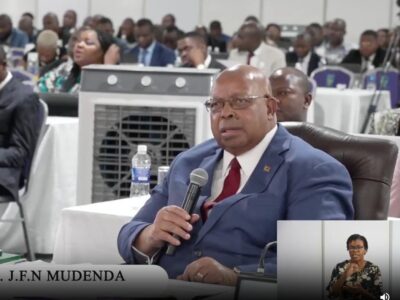By Ross Moyo
Government overspending has been blamed as one of the many risks behind devaluation of the new Zimbabwe Gold zig currency. Another risk factor from currency instability is that it would deter foreign investors worried about the ZiG as a reliable store of value. The prospect of declining business investment, loss of confidence in the ZiG, and anaemic consumption would in turn be a major drag on economic activity. Economic growth in 2024 is expected to slow down to 2% from 5% last year. El Niño-induced drought, lower mining prices, and macroeconomic instability are among the key reasons.
Fiscal and Monetary authorities have attempted to establish a stable national currency in the past 15 years now for the sixth time and this history of failed attempts has cast a long shadow on the ZiG. The recent devaluation has not eased concerns about Zimbabwe’s struggles to develop and maintain a domestic currency that can be widely used for transactions and as a store of value on a voluntary basis.
One finacial expert has long thought the devaluation was inevitable. Authorities must confront the fundamental causes, which are rooted in a loss of faith in the ability of government to manage spending. In particular, its habit of printing money, overspending on its budgets and failing to expand the economy.
The expert gave the following Interventions, ”The ZiG is part of a multicurrency system which allows individuals to use other major currencies including the US dollar, euro, South African rand and pound sterling.
”To increase the ZiG’s uptake, authorities imposed a number of measures. The new unit has to be used for paying a portion of company taxes and most government services. Fines are issued to traders unwilling to accept ZiG payments.
”Measures like these are not sufficient because they do not consider the real problems hindering success of the Zimbabwe dollar.
”The central bank also announced that it aims to slow the ZiG’s decline by imposing currency controls and raising the benchmark policy rate (the rate used to implement its monetary policy) from 20% to 35%. The jump in the cost of borrowing triggered by these measures will further weigh on business investment and consumer spending.
”Gains to Zimbabwean exporters from a cheaper ZiG are unlikely to be substantial because of an El Niño-induced drought which has devastated crops in southern Africa. And dollar earnings for Zimbabwe’s mineral exports have been hurt by lower commodity prices. The agriculture and food sector contributes about 17% to GDP and 40% of total export earnings on average, while mining accounts for about 12% of GDP and 80% of total exports,” added the expert.
Nevertheless the economic analyst worries that a cheaper ZiG may not juice exports and reduce the trade shortfall of US$1,453 million recorded last year, given the hit to commodity prices and adverse impact of drought on agricultural production. A bigger trade deficit will keep downward pressure on the currency. The weaker ZiG could however boost inbound tourism.
The economic commentator believes to retain a stable domestic currency, authorities will have to address deeper structural causes rooted in the country’s long history of printing money to pay for government overspending amid slow economic expansion. That means:
”slashing the budget while giving greater spending priority to health, education, public infrastructure and other critical investments.
”government weaning itself off dependence on printing money to finance fiscal deficits
”supporting credible policies for more sustainable and private-sector led growth and policies for capturing more revenue from growth.
Further the financial expert sees the following as Precedents,
”This is not the first time that the Zimbabwe dollar has been unstable and weak. In the 2000s, printing money to finance government deficit spending produced periods of high inflation amid slow growth, making the currency weak and unstable.
”The currency eventually collapsed in 2009 due to hyperinflation and the US dollar became the official currency.
”Another local currency (the RTGS dollar) was later introduced in 2019. With the power to print more money restored, inflation rapidly accelerated and surpassed 500% in 2020. This made the new Zimbabwe dollar highly unstable and its value quickly deteriorated.
”As a result, the US dollar continued to be the dominant currency used in transactions and as a store of value. Inflation remained elevated until April 2024, when the ZiG was launched as the new national currency. Its value is backed by gold and foreign currency reserves.
”At first the move seemed to have tamed inflation. But widespread voluntary use of the ZiG failed to materialise. That’s because people are still wary of the government’s power to print money, which had been the key driver of inflation and currency instability.”
The expert made the following recommendations on What policy makers can do,
”Authorities must tackle the root causes of the nation’s currency struggles once and for all. Steps that can be taken to resolve longstanding structural factors include:
”Re-prioritising public spending by undertaking deep fiscal reforms that will divert more resources towards spending on health, education, public infrastructure and other critical investments needed to boost growth. These reforms should also aim to capture more revenue from growth, for example, through tax reforms.
”Implementing reforms to address corruption and improve governance is essential for imposing the discipline necessary to push back against covering fiscal deficits by printing money and for restoring faith in government institutions.
”Pursuing credible policies for more sustainable and private-sector led growth. Strong growth expands tax revenues and gives the government more policy space to spend on essential services and critical investment needs.”
In essence like many other economic experts, Devaluation and other measures that have been imposed to support the ZiG are not the solution.
According to experts, Zimbabwe’s ZiG devaluations will not fix a currency that’s in trouble because of government overspending after the Reserve Bank of Zimbabwe devalued the ZiG by 43% on 27 September 2024. This weakened the official exchange rate from 13.9 ZiG per US dollar to 24.4 ZiG per US dollar.
Zimbabwe Gold, the nation’s newest currency was launched in April 2024 and the unexpected devaluation was prompted by the need to contain resurgent exchange rate pressure which started back in August due to higher food import costs and a slide in mineral export sales. The central bank decided to ease this pressure by lowering the value of the currency instead of burning reserves to keep its value steady at 13.9 ZiG per dollar.
This strain on the ZiG intensified in the aftermath of the devaluation. It weakened even further to more than 26 ZiG per dollar as of 18 October raising speculation that it will continue to weaken.
In light of this, it would have a number of negative consequences keeping upward pressure on import prices, hurting households and businesses. If this happened, Zimbabwean households already hit by falling paycheques and savings might cut back further on spending.
The risk of reigniting inflation caused by the strain on the currency also comes after monthly inflation ticked up to 1.4% in August and then climbed to 5.8% in September. Resurgent inflation would also increase costs for businesses and threaten to stifle investment. That was on display in 2000-08 and 2019-20 when price instability dampened economic activity and created a costly business environment which discouraged investment.















Comments